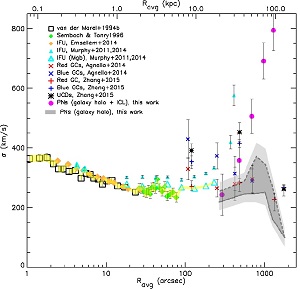- Details
- Published on 05 December 2018
Vol. 620
In section 4. Extragalactic astronomy
Kinematics of the outer halo of M87 as mapped by planetary nebulae
 Planetary nebulae (PN) are easy to detect through their ionized gas envelope, and because the Doppler effect on their ionized gas lines gives
an overview of the kinematics of the stellar haloes of galaxies. The present work focuses on a sample of nearly 300 PN around the brightest central galaxy of the Virgo cluster, M87. The velocity dispersion and its radial distribution, reveal subcomponents of the halo, which can be identified according to the specific angular momentum of their stars. Close to M87 (inside 10kpc), the dispersion decreases from 400 to 270km/s, and then rises again to 300km/s until a radius of 60kpc, and then falls again to 100km/s at 135kpc. The specific angular momentum remains low, which confirms that M87 is a slow rotator. However the dispersion is quasi isotropic inside the M87 halo (up to 70-90kpc), while radial anisotropy is strong in the outer parts. In the intermediate radii, there is a shell in the sea of stars, also known as a "crown" component, which confirms previous observations from the same group. This crown could be made of the stars from a recently accreted satellite. Outside of the crown, the PN traces a medium which has the dynamics of the Virgo cluster, and more specifically the Virgo A sub-cluster. The various components seen in the outer M87 halo are a warning to interpret the kinematics in terms of masses in the outer parts.
Planetary nebulae (PN) are easy to detect through their ionized gas envelope, and because the Doppler effect on their ionized gas lines gives
an overview of the kinematics of the stellar haloes of galaxies. The present work focuses on a sample of nearly 300 PN around the brightest central galaxy of the Virgo cluster, M87. The velocity dispersion and its radial distribution, reveal subcomponents of the halo, which can be identified according to the specific angular momentum of their stars. Close to M87 (inside 10kpc), the dispersion decreases from 400 to 270km/s, and then rises again to 300km/s until a radius of 60kpc, and then falls again to 100km/s at 135kpc. The specific angular momentum remains low, which confirms that M87 is a slow rotator. However the dispersion is quasi isotropic inside the M87 halo (up to 70-90kpc), while radial anisotropy is strong in the outer parts. In the intermediate radii, there is a shell in the sea of stars, also known as a "crown" component, which confirms previous observations from the same group. This crown could be made of the stars from a recently accreted satellite. Outside of the crown, the PN traces a medium which has the dynamics of the Virgo cluster, and more specifically the Virgo A sub-cluster. The various components seen in the outer M87 halo are a warning to interpret the kinematics in terms of masses in the outer parts.


